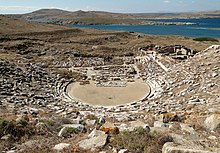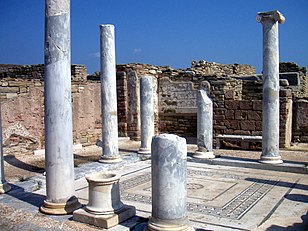Delos
Native name: Δήλος | ||
|---|---|---|
Region South Aegean | | |
| Regional unit | Mykonos | |
| Demographics | ||
| Population | 24 (2011) | |
| Pop. density | 6,8/km2 (176/sq mi) | |
| Criteria | Cultural: ii, iii, iv, vi | |
| Reference | 530 | |
| Inscription | 1990 (14th Session) | |
The island of Delos (
Delos had a position as a holy
.In 1990,
History
Ancient Greece


Investigation of ancient stone huts found on the island indicate that it has been inhabited since the third millennium BC.
Between 900 BC and 100 AD, Delos was a major cult centre, where the
A number of "
After the
During the
The island had no productive capacity for
Suda writes that the Greeks used the proverb "ᾌδεις ὥσπερ εἰς Δῆλον πλέων", meaning you sing as if sailing into Delos in reference to someone who is happy, light-hearted, and enjoying himself.[8]
Iamblichus writes that Delos Mysteries (similar to the Eleusinian Mysteries) were established.[9]
Roman era
Strabo states that in 166 BC, the Romans converted Delos into a free port, which was partially motivated by seeking to damage the trade of Rhodes, at the time the target of Roman hostility. In 167 or 166 BC, after the Roman victory in the Third Macedonian War, the Roman Republic ceded the island of Delos to the Athenians, who expelled most of the original inhabitants.[10] Roman traders came to purchase tens of thousands of slaves captured by the Cilician pirates or captured in the wars following the disintegration of the Seleucid Empire. It became the center of the slave trade, with the largest slave market in the larger region being maintained here.
The
Despite its decline, Delos maintained some population in the early Roman Imperial period. Pausanias (8,33,2), writing in the second century AD, states that Delos was uninhabited apart from a few custodians of the sanctuaries. Evidence has been found of Roman baths, coins, an aqueduct, residential and elite houses, multiple churches, basilicas, and a monastery all from the first to sixth centuries AD, which, however, does not suggest that the island was continuously inhabited in the period.[12][13] The pottery found indicates that produce, such as wine and oil, continued to be imported from regional centres. Also, a number of wine presses were found amidst the ruins of the ancient city that date to this period, suggesting that the population at this time was engaged in considerable viticultural endeavour.[14]
Delos was eventually abandoned around the eighth century AD.[15]
Landmarks

- The small topographicalfeature that determined the placement of later features.
- The Minoan Fountain was a rectangular public well hewn in the rock, with a central column; it formalized the sacred spring in its present sixth-century BC form, reconstructed in 166 BC, according to an inscription. Tightly laid courses of masonry form the walls; water can still be reached by a flight of steps that fill one side.
- Several market squares were found; the merchant guildsdedicated statues and columns there.
- The Temple of the Delians, dedicated to Apollo, is a classic example of the Doric order. Beside the temple, once stood a colossal kouros of Apollo, only parts of which remain. Dating to the sixth century BC, parts of the upper torso and pelvis remain in situ, a hand is kept at the local museum, and a foot is in the British Museum.[17]

- The Terrace of the Lions, also was dedicated to Apollo by the people of Naxos shortly before 600 BC. It originally had 9-12 squatting, snarling marble guardian lions along the Sacred Way; one was removed and is presently situated over the main gate of the Venetian Arsenal. The lions create a monumental avenue comparable to Egyptian avenues of sphinxes. (A Greek sphinx is in the Delos Museum.) Today, only seven of the original lions remain.
- The Oikos of the Naxians (House of the Naxians), first quarter of sixth century BC, has a long hall with one central ionic colonnade, a west porch tristyle in antis, and an east marble prostasis of the middle of the sixth century BC.[18]
- The Establishment of the Poseidoniasts, clubhouse of "the Roma.

- The .
- The Temple of Hera, circa 500 BC, is a rebuilding of an earlier Heraion on the site.
- The House of Dionysus is a luxurious second-century private house named for the floor mosaic of Dionysus riding a panther.
- The House of the Dolphins is similarly named from its .
- The Stoivadeion dedicated to Dionysus bears a statue of the god of wine and the life-force. On either side of the platform, a pillar supports a colossal phallus, the symbol of Dionysus. The southern pillar, which is decorated with relief scenes from the Dionysiac circle, was erected around 300 BC to celebrate a winning theatrical performance. The statue of Dionysus was originally flanked by those of two actors impersonating Paposilenoi (conserved in the Archaeological Museum of Delos). The marble theatre is a rebuilding of an older one, undertaken shortly after 300 BC.
- The “Delos Synagogue”, the ruins of what was once believed to be an ancient Samaritan synagogue.[22]
Current population
The 2001 Greek
According to more recent numbers, in 2011 the island counted 24 inhabitants.
Gallery
-
The Theatre Quarter
-
Sacred Way
-
Establishment of the Poseidoniasts
-
House of Cleopatra
-
Statues at the House of Cleopatra
-
Temple of Isis
-
Bust of Hermes
-
Agora of the Italians
-
Heraion (Temple of Hera)
See also
- Delia (festival)
- Delian problem
- History of the Cyclades
References
- ^ The combination -nth- is a marker for Pre-Greek words: Corinth, menthos, labyrinth, etc. A name Artemis and even Diana retained was Cynthia.
- ^ "Delos". UNESCO World Heritage Convention. United Nations Educational Scientific and Cultural Organization. Retrieved 20 November 2022.
- ^ Thucydides, I,8.
- ^ Thucydides, III,104.
- ^ Thucydides, V,1.
- ^ Thucydides, I,96.
- ISSN 0007-4217.
- ^ Suda, alpha, 455
- ^ Iamblichus, Life of Pythagoras, § 28.151
- ISBN 8882653056.
- ISBN 8882653056.
- OCLC 1139263254.
- OCLC 919408437.
- OCLC 1139263254.
- OCLC 1139263254.
- ^ "Sacred Lake | Greece Attractions". Lonely Planet. Retrieved 2020-04-12.
- ^ British Museum Collection
- ^ Gruben G., Griechische Tempel und Heiligtümer, München, 2001
- ^ Gazette numismatique suisse. 1992. p. 124.
- ISBN 9780826210999.
- ^ Hephaistos. 2006. p. 129.
- ^ Delos
Further reading and viewing
- Reger, Gary (1994) Regionalism and Change in the Economy of Independent Delos. Berkeley, Los Angeles and Oxford: University of California Press.
- Tréheux, Jacques (2023). Études critiques sur les inventaires de l'indépendance délienne. Athènes: École Française d'Athènes. ISBN 9782869585669.
- Vial, Claude (1984) Délos indépendante. Bulletin de correspondance hellénique Supplement X. Athens.
- Vial, Claude (2008) Inscriptions de Délos. Index, tome II: les Déliens (Paris: De Boccard)
- Delos: Island at the Center of the World. Princeton, New Jersey: Films for the Humanities and Sciences, 2006.















